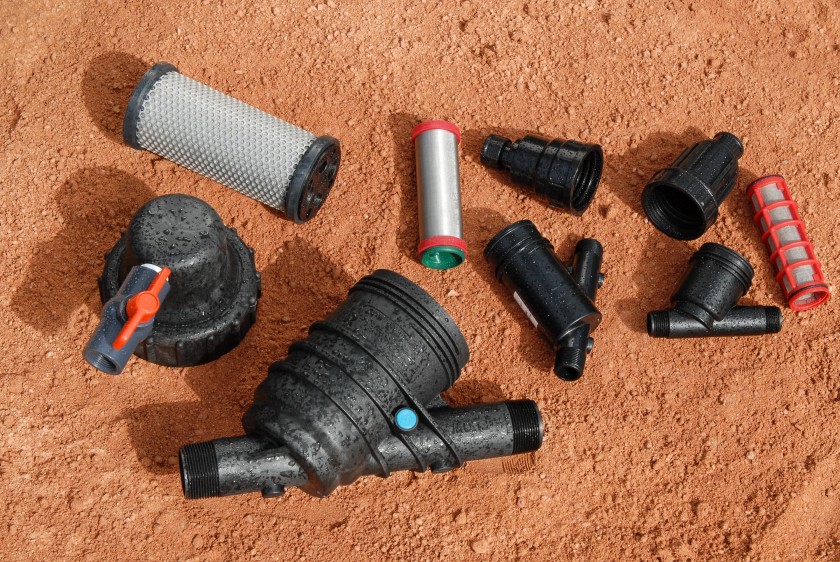6 Steps to Prep Your Irrigation System for the Growing Season
Checklist can help reduce water use in the garden yet keep landscape looking healthy
By Richard Restuccia
(This article originally appeared in the San Diego Union-Tribune May 8, 2021)

Examples of filters you may find on your system. Look near the valves to locate these.(Michael Derewenko)
In San Diego, the colder winter months take a toll on irrigation systems. To ensure that your system gives you its best performance before the heavy watering of summer starts, here are six steps to take right now. Spring is a perfect time to perform maintenance because finding issues early in the season helps you save water, save money and improve the look of your landscape all summer long.
Proper care of your system includes additional inspections and services during the summer months, too. Establish a regular and routine maintenance schedule to keep your system working well and to minimize water waste.
Step 1: Visually inspect all your irrigation components to ensure that they will operate correctly when the water is turned on. This is one of the most simple — and often neglected — steps. Review the system components regularly. Turn on all the stations weekly or after every mowing. Most controllers allow watering in a manual water mode. This turns on the water to each zone for a specific number of minutes and moves zone to zone. This gives you enough time to examine the system walking from zone to zone, noting problems to repair after the inspection.
Clogged heads, broken lines, or leaks will be detected early with regular inspections, which also significantly reduce the potential for water waste. To clean any clogged spray heads, unscrew them and rinse them in a bucket of water. Give the spray heads a good shaking, inspect for any debris in the screen, then screw them back on.
Step 2: Clean your filters. When was the last time you cleaned your filters? A typical response to the question is — what filters? Clean filters are critical to the success of any irrigation system. Cleaning them is easy and should be performed regularly. For irrigation systems using municipal water, cleaning your filters once a month during the irrigation season is sufficient. You can remove the filter and clean it by hand. Flushing screen filters clean themselves and are an excellent choice for anyone who wants to reduce maintenance time. Many filters have flush outlets. Opening the outlet and letting the water flush the screen works well. Some filters open a flush valve every time the system is charged. This is especially helpful for dirty water applications.
Step 3: Check the controller. Spring is a great time to reprogram your controller or replace a conventional device with a smart controller. The latter adjusts the watering schedule based on the weather. Check with your water agency to see if any water restrictions are in place, and adjust your controller accordingly. Confirm that the programs are set correctly, and look for ways to reduce water use.
Most water agencies offer rebates for smart controllers. The San Diego Water Authority offers incentives that start at $80 per controller for residential sites with less than one acre of landscaping. For larger residential sites, incentives start at $35 per station. Rebates cannot exceed the purchase price of the controllers. Visit SoCal WaterSmart or call (888) 376-3314 for more information. Make sure to look for the WaterSense label.
Step 4: Rinse it out. For drip systems, now is a great time to remove your end caps and flush the system. Once you remove the end caps, run water through the system for two to three minutes to remove any debris that could clog your emission devices.
Step 5: Reduce your use. Follow this checklist for ways to reduce water use in your garden. Remember, because drip irrigation places water right in the root zone, it is often twice as efficient as conventional spray-head irrigation.
- Could nonfunctional turf areas be replaced with native or drought-tolerant shrubs?
- Is subsurface irrigation feasible or desirable in any turf areas?
- Can spray heads in shrub or color beds be converted to drip irrigation?
- Can any of the high water use plants be replaced with low water use plants?
- Do shrubs block heads and limit coverage?
- Is the pressure of the system too high and causing too much misting and evaporation?
- Are the controllers correctly programmed? Are run times too long? Can more days be programmed between waterings? Is watering scheduled at poor times, like midday?
- Would rain sensors be beneficial? Do you shut all controllers off after rainfall?
Step 6: A few additional items to consider. Good horticultural practices in tandem with good irrigation practices are essential for good water management. It is crucial to understand how much water your plant needs and how much water your system delivers. Your irrigation system needs changes and modifications as a landscape matures. For example, new plants require more frequent watering than mature plants. Finally, a regular maintenance program will extend the life of your system. Many consumers with good irrigation maintenance are getting 20 years out of their systems.
Make a regular inspection of your irrigation system part of your gardening routine, and you will be paid back with lower water bills and a more beautiful garden.
Restuccia is a member of the UCCE San Diego County Master Gardener Class of 2018. Get free gardening advice on the Master Gardener Hotline, (858) 822-6910, or by email at gro.dsrenedragretsamnull@pleh. Due to COVID-19, the Master Gardener Hotline staff members are working remotely to ensure they respond to your questions in a timely manner.

